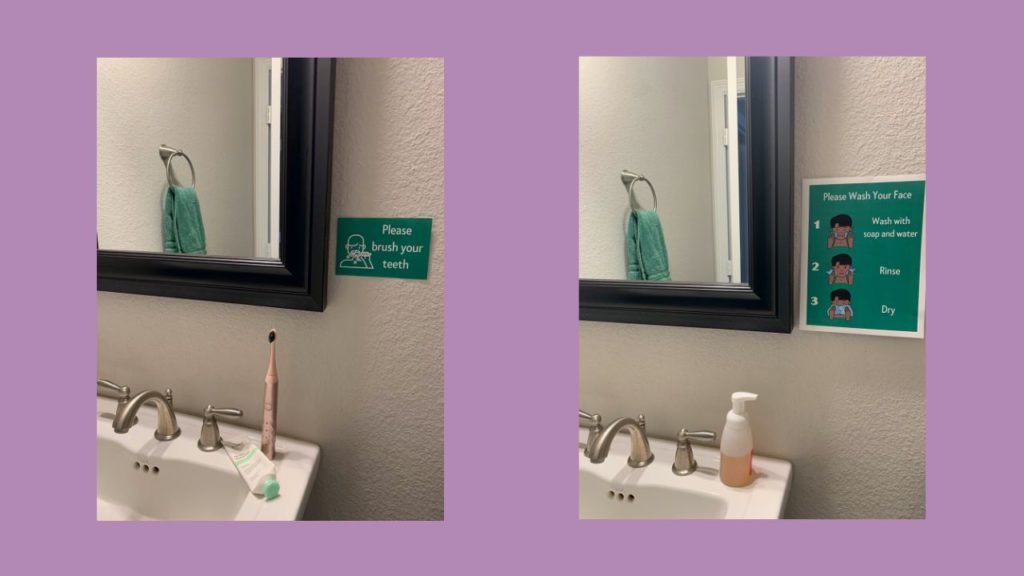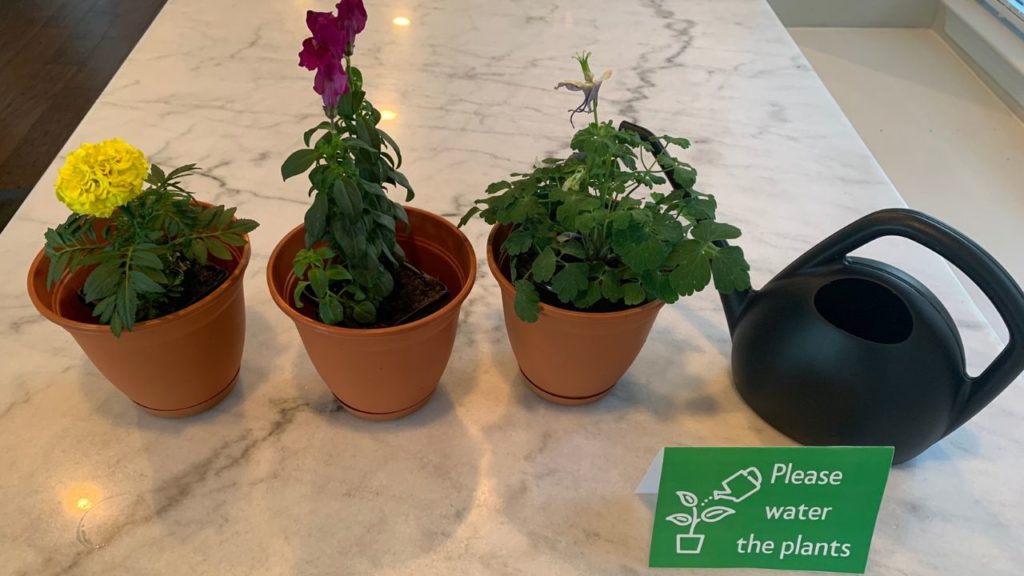Is your loved one having trouble cooking, paying bills, sending emails, or doing other everyday tasks that were once easy for them? Have they been getting frustrated and angry more easily, maybe even getting short with you while trying to make a phone call or heating up food?
These are all signs that a person may be struggling with sequencing. It is one of the first things people with dementia start to have trouble with that is noticeable and often sends people to a doctor to get a diagnosis.
Key Points:
- An early sign of dementia is trouble completing daily tasks, which is called sequencing.
- Using sequencing signs can help a person complete tasks again.
- The ability to maintain as much independence as possible greatly increases quality of life and decreases anxiety and depression.
- Signage must be introduced properly for it to work, just putting up signs is not enough.
What is Sequencing?
Sequencing is the ability to follow the steps of a task in the right order. It is one of our executive functions, which are cognitive processes that allow us to plan, focus, handle multiple tasks, and remember instructions.
All of us use sequencing, every day. You can’t brush your hair, drive a car, finish a work project, or take your dog for a walk without sequencing.
Typically procedural memory created through repetition allows us to sequence most of our daily tasks such as tying our shoes, or work or hobbies such as even managing a stock portfolio if that is one’s profession.
Things that are not so automatic for us take a bit more memory to recall the sequences, and sometimes we need to figure out the sequence for a task, such as working on a new work or school project.
Any one of us can struggle with sequencing. Sequencing and other executive functions are one of the biggest struggles when we are sleep deprived. That’s why even just making your coffee in the morning after too little sleep seems difficult.

Sequencing Signage Improves Quality of Life
Simple signs in the environment can help give a person with dementia more independence, personal agency, and decreased agitation and sadness.
Signage is a type of memory or communication aid. A memory aid is a written and/or visual cue that helps a person function better.
With a memory aid, we are finding a way to support gaps or struggles in cognition so that a person can complete a task, know what to do, know where to find what they need, get answers to questions, and do things they love.
With sequencing signage, we are helping a person complete tasks more independently and/or with less agitation or confusion.
We actually all have signage that helps us function in our life. Road signs help us not get lost. Stores use signage to help us find what we are looking for (and other visual cues to get us to buy more than we intended!)
Many offices have sequencing signage. One common place is at the coffee maker with the steps to make coffee. Project managers often use whiteboards with the steps needed to finish a project so that everyone knows what step they are working on and what step is next. That is a form of sequencing signage.
When we do not know the steps to complete a task, it can feel disempowering and embarrassing. Most people feel a bit embarrassed if they can’t figure out the coffee maker at the office. Imagine having trouble doing things you used to do every day.
How Does Signage Work?
For all of us, 90% of our decisions and behaviors are automated.
If our brain had to make a new decision every moment of every day we would be mentally and physically fatigued in an hour.
Based on the process of: repetition of a cue that leads to an action and then a result, our brain has automated most things in life. This process uses two parts of cognition- habit formation and procedural memory.
For example, putting toothpaste on the toothbrush before you put it in your mouth is not something you have to make a decision about. This is because of the brain wiring of habit in the basal ganglia of the brain, as well as a function of procedural memory- the type of memory that remembers how to do a task.
Procedural memory is preserved long into the course of dementia and it is one of the best things to tap into in order to help people live better with dementia. (1, 2)
Part of procedural memory is sequencing of tasks. This is the sequence of steps, in the right order, that you need to take to complete a task. Everything we do requires us to remember a sequence.
You can turn on your car because your brain has wired in the sequence of putting the key into the ignition and turning it. But every time you get a new car, you need to learn a new sequence in order to use the car. If you got a car with a remote starter, for the first few weeks you might try to put a key in and turn it, even though you do not need to anymore.
If there was a sign that told you the basic steps to start your car, you would not accidentally try and put a key in and after probably just a few days, the new sequence would be wired into your brain.

Signage Supports Ability to Complete Tasks
Signage triggers a person to do a task, it cues procedural memory, and it supports the ability to sequence a task in order to complete a task.
Sequencing of a task is one of the first cognitive abilities to become impaired early on in most dementias. Inability to start a task is another symptom we see early on as well. Sequencing signage helps in both of these areas.
You will need to learn where your loved one needs cognitive support in order to cue procedural memory and assist in sequencing.
For example, the cue of just seeing a toothbrush may not be enough of a cue anymore to know to put the toothpaste on the brush, then put the brush in your mouth, and then brush your teeth. Signs can help.
There are two types of signage that help with sequencing based on cognitive need:
- Invitation signs: These signs invite someone to do a task. They can be used in order to provide meaningful engagement with activities (such as “please play solitaire”) or to cue the brain to do an activity or task (such as “please brush your teeth.”)
- Sequencing signs: These signs help support gaps or confusion in sequencing by showing the steps to a task. For example, a tooth brushing sign could be an invitation that says “Please brush your teeth,” but if a person then has trouble sequencing, they may not know what steps to take in what order to brush their teeth. Then you would use a sequencing sign with images and a few words for each step to trigger the brain. For many people in early stage dementia, sequencing signage that is just written numbered step by step instructions to complete a task, such as using the oven, are enough.
Using Signage Correctly
Signs need to be presented correctly and repetition is needed in order for sign use to be successful. People with dementia learn by repetition. (Actually, that’s the way we all learn!)
Tips for presenting and using signage:
- Start with one sign for the thing they need the most help with. Demonstrate looking at the sign, read it aloud, and then demonstrate doing what the sign shows.
- After you demonstrate using the sign yourself, then invite them to use the sign. Ex: “How about you wash your hands now?”
- Many people will not know to use the signs or look for them after one introduction to them. Daily, walk them over to the signs and demonstrate using them as often as possible.
- The process of looking for and then using the signs must be repeated often in order for the brain to wire using the signage.
Repetition also provides a sense of safety and consistency by letting the brain know what to do. Everyone has increased anxiety when we are in a place or situation where we do not know what we are supposed to be doing. This is one place where we see a lot of responsive behaviors such as hitting, pushing, refusal of care, arguing, or depression. Helping the brain know what to do when can drastically decrease these behaviors and increase peacefulness for all care partners.
Signage For Better Living
Signage is one of the simplest supports we can use to help people with dementia live well. In fact, starting to use them as early as possible is the best way to ensure that they work well as a person’s dementia progresses.
This means that in early dementia, if a person is struggling to use their email, pay bills, or do other tasks, simply typing out the steps to check their email can be a great support. This gets them used to using signs, creating a habit of using signage which will help later when they need signage for more tasks. This also normalizes the use of signage, which in reality we all use at times.
If you would like to learn more about sequencing signage, invitation signs, and wayfinding signs, you can get my ebook, Using Signage in Dementia Care. It also comes with over 70 printable signs for many common tasks as well as includes fillable signs so you can create your own.
I hope that this article helps give you more confidence as a care partner, knowing that people with dementia can still do things they love and have personal agency in life, with the addition of some simple supports.

